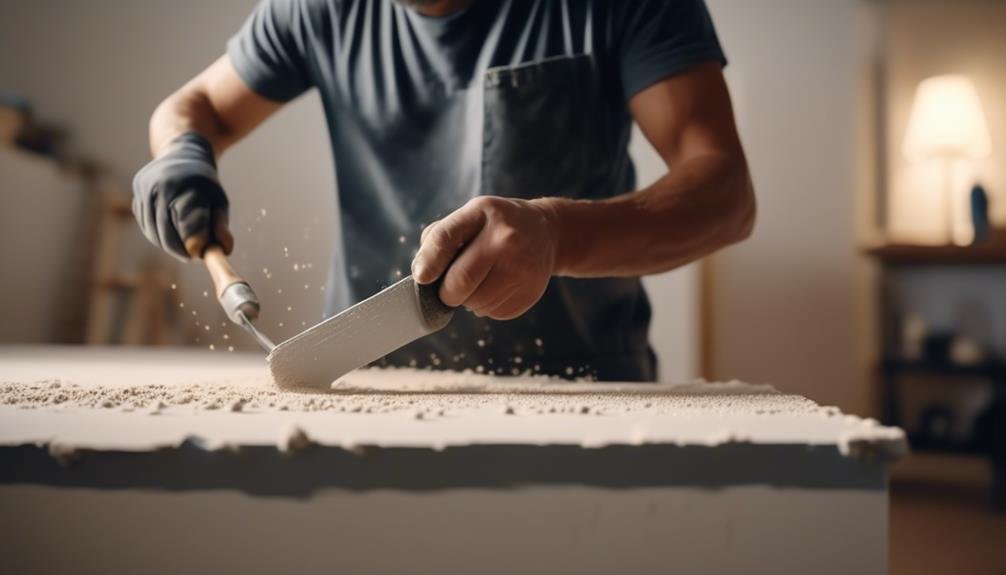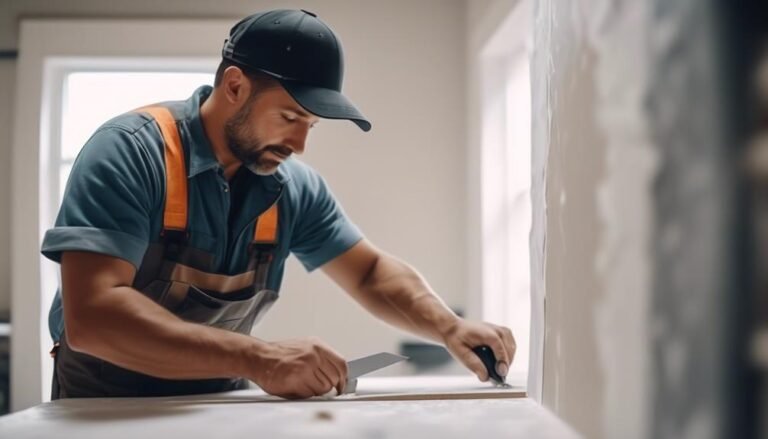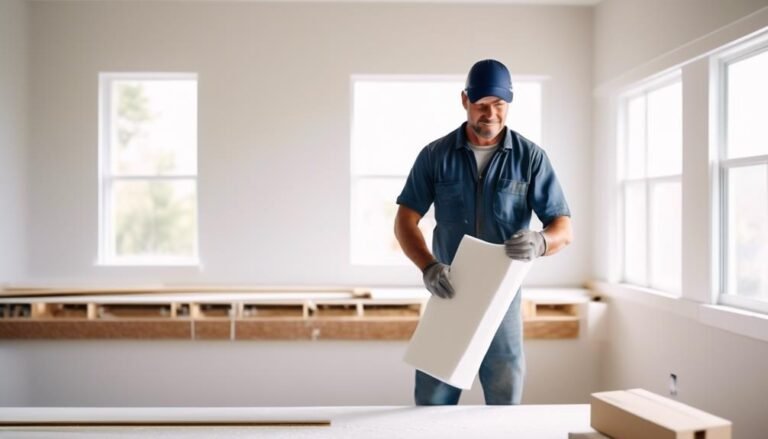Economical Drywall Repair in Antonio: A How-To Guide
As a homeowner in Antonio, you're probably familiar with the common issue of drywall damage. In fact, over 80% of homes experience some form of drywall damage within the first 10 years of construction.
But you might not know how to handle these repairs without spending a lot of money. In this guide, we'll show you cost-effective methods to repair drywall, from small fixes to more extensive repairs.
By the end, you'll have the knowledge and skills to handle drywall repairs economically and efficiently, ensuring a professional-looking result.
Key Takeaways
If you're a homeowner in Antonio, chances are you've dealt with the frustration of drywall damage. It's a common issue that affects over 80% of homes within the first 10 years of construction.
But fixing these repairs doesn't have to break the bank. In this guide, we'll show you budget-friendly ways to repair drywall, whether it's a small patch or a larger area.
By the end, you'll have the know-how to tackle drywall repairs without spending a fortune, and you'll be able to achieve a professional-looking finish.
Understanding Drywall Repair Basics
When fixing drywall, safety is crucial. Before you start, make sure there are no live wires behind the area that needs fixing. Once you've confirmed the safety of the workspace, you can proceed with the repair.
Begin by cutting a piece of drywall to fit the hole or damaged area. One popular method for patching drywall is the California Patch, which involves cutting a piece of drywall that's about 2 inches larger than the hole all around. Once you have your piece cut, secure it in place with screws or nails.
After securing the patch, you'll need to apply joint compound over the seams and let it dry. Sand the area lightly to create a smooth surface. Remember, patience is key when it comes to drywall repair. Rushing through the process can lead to a less-than-perfect result.
Once the patch is sanded and smooth, you can prime the area before painting. These basic steps will help you tackle drywall repair with confidence and freedom.
Small Drywall Fixes for Minor Damage
Dealing with small damage to your drywall?
First, gather the basic tools you'll need: drywall joint compound, painters putty, taping knives, a utility knife, and sandpaper.
Small fixes are a great way to practice applying drywall joint compound and understand the process. Depending on the type of damage, you may also need mesh tape or other additional materials commonly used in home construction and interior painting.
When patching dings and dents, make sure to follow the proper steps: clean the area, apply the compound, and allow it to dry before sanding the surface.
Patience is key to achieving a smooth and seamless finish.
Repairing Holes in Drywall

Repairing holes in drywall is a common task for homeowners. It's important to carefully assess the size of the hole and gather all the necessary tools and materials before getting started. Whether it's a small hole from a picture hook or a larger hole from accidental impact, you can tackle this DIY project with the right approach. Here's how to do it:
- Assess the size of the hole: First, figure out whether the hole is small, medium, or large. This will help you understand the best approach for the repair.
- Gather necessary tools and materials: Make sure you have a putty knife, sandpaper, joint compound, drywall tape, and wire mesh for larger holes. Having these items ready will make the repair process smoother.
- Reinforce larger holes: If you're dealing with a larger hole, use wire mesh and drywall tape to create a strong foundation for the patch. This will ensure a sturdy and long-lasting repair.
- Follow specific methods for patching: Different techniques are used to patch small, medium, and large holes. Be sure to follow the appropriate method for the size of the hole to achieve the best results.
Repairing holes in drywall can be a satisfying and cost-effective way to maintain your home. However, if you're unsure about the best approach or if the repair is complex, it's always a good idea to consult a professional. This is especially important when dealing with corner bead repairs.
DIY Finishing Techniques for a Professional Look
When finishing drywall, it's important to use a light touch with a fine-grit sanding sponge to create a smooth surface. This technique helps blend the joint compound for a seamless finish.
Priming the area before painting is also crucial for consistent color and allowing it to dry completely before repainting.
Applying thin coats of joint compound and sanding between coats can result in a flawless finish.
Make sure electrical boxes are hung at the correct height and use a level for proper alignment.
Using tools like cutout tools, corner tools, and drywall dimply bits can speed up the DIY finishing process.
These techniques empower you to take control of the repair process and achieve a high-quality result without the need to hire a professional.
Additional Resources for Economical Drywall Repair

If you're looking for more ways to save money on drywall repair, consider checking out a comprehensive DIY guide for replacing a washer pump. This guide offers practical tips and techniques that can be adapted for drywall repair, helping you cut costs on materials and labor.
In addition to the washer pump guide, here are some other resources to consider for affordable drywall repair:
- A Guide to Building an Affordable Kitchen Island: Learn about budget-friendly materials and construction methods that can be applied to drywall repair projects.
- Cost Considerations for Different Drywalling Techniques: Explore budget-friendly options for repairing drywall, such as patching, texturing, and finishing methods.
- Time-Saving Techniques for Drywalling: Discover efficient and cost-effective ways to complete drywall repair projects without sacrificing quality.
- Effective Use of Mesh Tape: Learn how to use mesh tape effectively for seamless and durable drywall repairs, saving both time and money in the process.
Frequently Asked Questions
What Is the Easiest Way to Repair Drywall?
Repairing drywall is as easy as spreading frosting on a cake. Simply fill the hole with compound, smooth it out, and sand it down. After that, give it a fresh coat of paint for a seamless finish. This is important because it helps maintain the appearance and integrity of your walls. Plus, it saves you money on hiring a professional for a simple fix. So go ahead and give it a try, you'll be surprised at how easy it is!
How Much Does It Cost to Fix a Large Hole in the Wall?
If you're a homeowner dealing with a big hole in the wall, getting it fixed by a professional can cost you anywhere from $50 to $300. If you decide to do it yourself, you can expect to spend between $20 and $150 on materials and tools. Keep in mind that you may also need to budget for paint and primer. Fixing that hole is important to maintain the appearance and integrity of your home. Plus, it can save you money in the long run by preventing further damage.
Are Drywall and Sheetrock the Same Thing?
Drywall and sheetrock might seem like two peas in a pod, but here's the scoop: Sheetrock is actually just a specific brand of drywall. Both are made of gypsum plaster and paper, but sheetrock is a particular type.
For homeowners, it's important to know that when you hear "sheetrock," it's essentially referring to a type of drywall. This distinction can be helpful when you're working on home improvement projects or speaking with contractors.
Should I Repair or Replace Drywall?
Assess the damage to your drywall and consider the cost and effort of repairing or replacing it. If you're unsure, it's a good idea to seek professional advice. Keep in mind that replacing the drywall might be more cost-effective and provide longer-lasting results in some cases.







